YOJANA JULY 2024
Chapter 1- Impact of Food Processing on Employment Generation and Skill Development
Food Processing: It is the process of converting unprocessed agricultural and livestock items into processed and higher-value food products that are appropriate for consumption.
- This industry includes a variety of activities, technologies, and methods designed to make food products safer, more convenient, and longer-lasting, while also improving their taste and nutritional content.
- It is a crucial component of the overall food supply chain.
Status and Role of Food Processing Sector in India:
- The Gross Value added (GVA) in the food processing sector was Rs.2.24 lakh crore in 2019-20 contributing 1.69% of the total GVA in the country. It constituted as much as 9.87% and 11.38% of GVA in Manufacturing and Agriculture sector respectively in 2019-20 (at 2011-12 prices).
- During the last 5 years ending 2021-22, FP sector has been growing at an Average Annual Growth Rate (AAGR) of around 8.38%.
- According to the latest Annual Survey of Industries (ASI) for 2019-20, the total number of persons engaged in registered food processing sector was 20.32 lakh. Unregistered food processing sector supports employment to 51.11 lakh worker as per the NSSO 73rd Round, 2015-16.
- The FDI equity inflow in the Food Processing Sector for the period of April 2021-March 2022 was USD 709.72
- The total FDI received in the food processing sector since April 2000 till March 2022 was USD 11.08 Bn GDP (Gross Domestic Product) measures the monetary value of all final goods and services produced in a country during a given period. The key “engines of GDP growth” are:
|
1. Private Final Consumption Expenditure (PFCE) - money spent by individuals 2. Government Final Consumption Expenditure (GFCE) - government spending on current consumption 3. Gross Fixed Capital Expenditure - investments to boost productive capacity 4. Net Exports (exports - imports) GDP = PFCE + Gross Investment + GFCE + Net Exports GVA (Gross Value Added)calculates national income from the supply side by adding up the value added across different sectors. GVA of a sector is the value of output minus the value of intermediary inputs. Relationship between GDP and GVA: GDP = GVA + Taxes - Subsidies GDP data is more useful for analyzing annual economic growth and comparing economic performance between countries. |
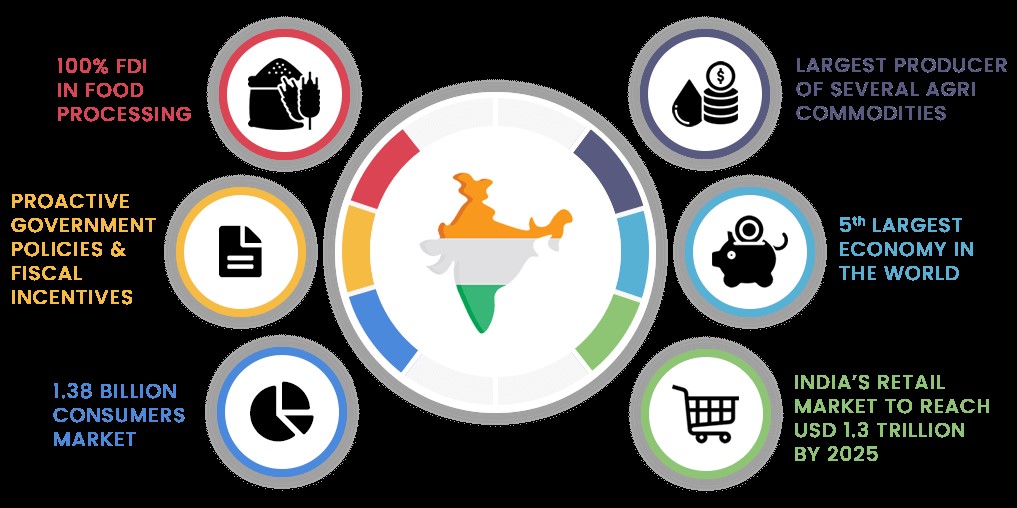
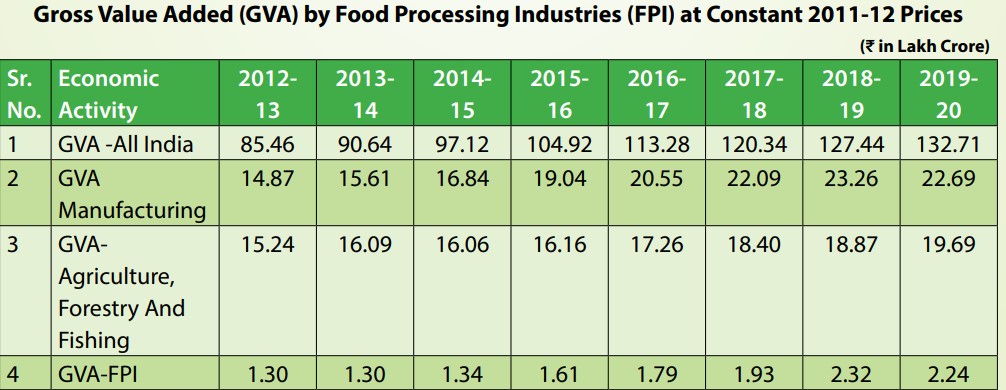

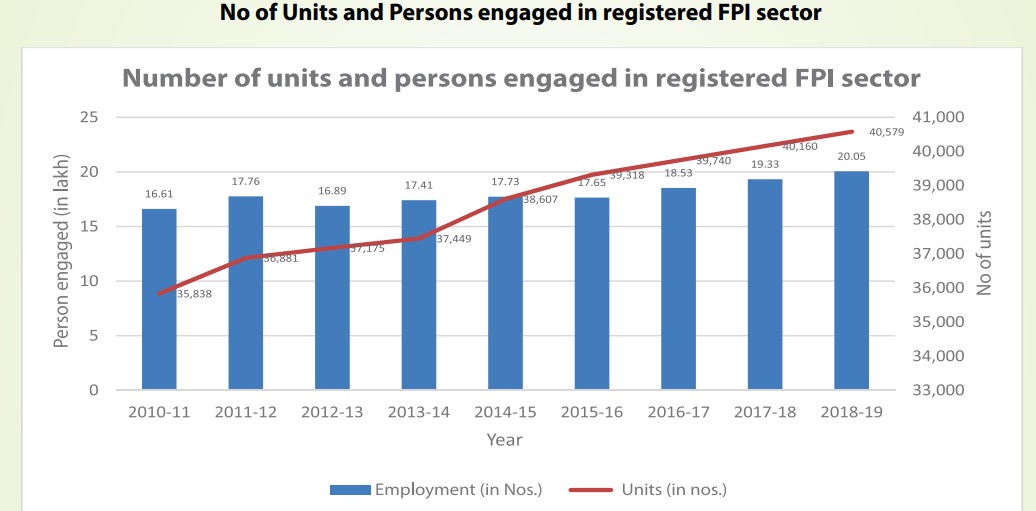
State Wise Distribution of Registered and Unincorporated Food Processing Units in India:
- According to the Annual Survey of Industries 2018-19, there were 40,579 factories in the registered food processing sector in India.
- The highest number of these factories were located in Andhra Pradesh, accounting for 13.93% of the total, followed by Tamil Nadu with 12.28%, Telangana with 9.61%, Punjab with 7.67%, and Maharashtra with 6.88%.
Skill Development Initiative in the Indian Food Processing Industry
- Collaborative Efforts and Course Development:
- MoFPI and FICSI work together to validate Qualification Packs (QPs) for job roles in the food processing sector. The National Institute of Food Technology Entrepreneurship and Management (NIFTEM) develops relevant course curricula. Regular stakeholder meetings ensure progress and adjustments.
- Pradhan Mantri Kisan SAMPADA Yojana
- This scheme focuses on developing training modules in multiple languages and creating infrastructure for skill training centers
- National Occupational Standards Development
- FICSI, with Ernst & Young (E&Y), identifies job roles and required competencies to develop National Occupational Standards (NOS) across various sectors like fruits and vegetables, dairy, meat, fish, bakery, beverages, and packaged foods, including common standards for packaging and quality analysis.
- Skill Development and Entrepreneurship Programs
- NIFTEM and the Indian Institute of Food Processing Technology (IIFPT) conduct regular skill and entrepreneurship programs for youth, farmers, and industry professionals. MoFPI promotes entrepreneurship through these programs and has included an entrepreneurship module in all job role curricula.
Role of NABARD in Food Processing and Storage Infrastructure:
NABARD has been entrusted with the critical task of enhancing the country’s agricultural storage and food processing capabilities through the Warehouse Infrastructure Fund (WIF) and the Food Processing Fund (FPF). This has led to reduced post-harvest losses, promoted the growth of the food processing sector, improved farmer access to wider markets, and fostered the development of agro-processing clusters and food parks.
- Warehouse Infrastructure Fund (WIF)
- The WIF, with a corpus of ₹10,000 crore, aims to create scientific storage infrastructure in rural areas. Key achievements include sanctioning ₹9,452.61 crore for 8,162 projects, resulting in 13.74 million MT of storage capacity, and collaborating with stakeholders to upgrade and accredit existing warehouses.
- Food Processing Fund (FPF)
- The FPF, with a corpus of ₹2,000 crore, promotes the growth of the organized food processing industry by providing affordable credit for setting up designated food parks and processing units. Key achievements include sanctioning ₹1,191.57 crore for 41 projects, covering 1,370.03 acres and creating processing infrastructure like warehouses, silos, and cold storage.
|
NABARD is the apex development financial institution for agriculture and rural sectors in India, established in 1982.
|
Investment Potential in Food Processing Sector:
- 100% Foreign Direct Investment (FDI) is allowed under the automatic route in the food processing sector in India.
- Additionally, 100% FDI is permitted through the Government approval route for trading, including e-commerce, of food products manufactured or produced in India.
- From April 2014 to March 2023, the sector received an FDI equity inflow of USD 6.18 billion.
Chapter 2- Challenges and Growth Potential for Food Processing Industries
Challenges to Food Processing Sector:
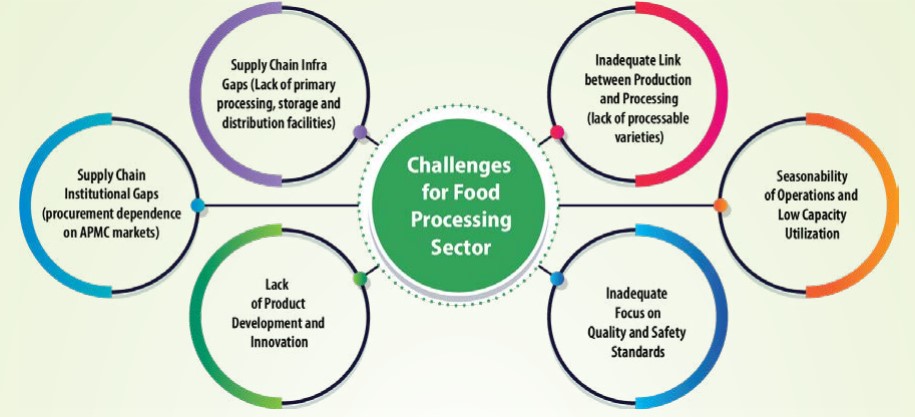
Opportunities for Food Processing Sector:
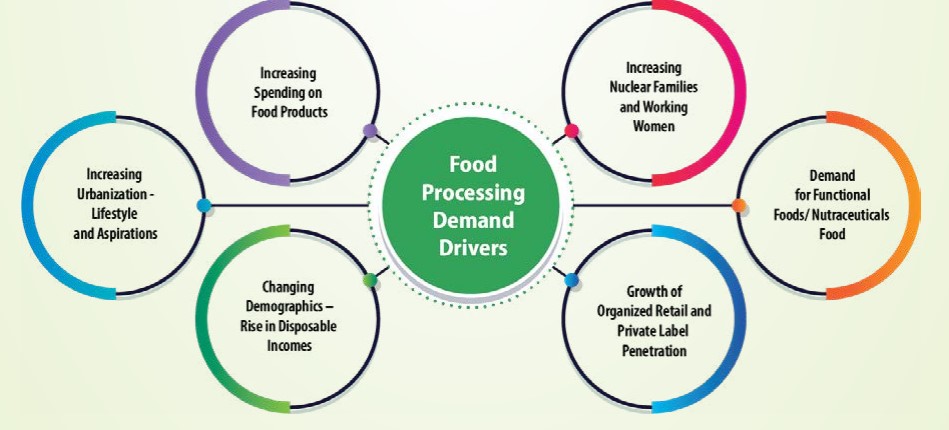
Chapter 3- Export Potential and Global Competitiveness of Indian Processed Foods
India, the second largest producer of food globally, possesses immense potential to be a major player in the processed food sector. Yet, despite a robust agricultural base and a growing domestic market, India’s share in global processed food exports remains minuscule.
- Low Processing Rates: India processes only around 2% of its agricultural produce compared to the global average of 10%. This translates to a missed opportunity to add value and extend shelf life.
- Limited Export Share: Despite a 15% growth rate in processed food exports, India captures a mere 1.7% share of the global market, highlighting a significant gap between potential and reality
- Infrastructure Bottlenecks: Inadequate cold storage facilities and logistics networks lead to spoilage and inefficiencies, increasing costs and hindering timely delivery.
- Compliances and Standards: Complex regulations and stringent international food safety standards pose challenges for Indian exporters, especially small and medium enterprises.
- Brand Building and Marketing: Limited brand recognition and a lack of targeted marketing strategies restrict access to premium international markets.
Strategies for Success:
- Boosting Processing Capacities: Government initiatives like the “Mega Food Park Scheme” can incentivize investments in food processing infrastructure to minimize wastage and improve efficiency.
- Focus on Value Addition: Encouraging production of high-value processed food items like ready-toeat meals and organic products can cater to the growing global demand for convenience and healthconscious options.
- Streamlining Regulations: Simplifying compliance procedures and adopting international standards will ensure seamless integration into global supply chains
- Promoting Brand India: Targeted marketing campaigns showcasing the unique flavors and quality of Indian processed foods can build brand recognition and consumer trust.
Import and Export of Agri-Food Products
- The value of agri-food exports including processed food exports during 2020- 21 was of the order of USD 38.32 Billion accounting for about 13.2% of India’s total exports (total exports USD 291.17 Billion).
- The value of import of agri-food items including processed food during 2020- 21 was USD 20.99 Billion which was 5.3% of India’s total imports (total imports USD 393.61 Billion).
- The share of India’s agri-food exports in the world was 2.31% in 2020 and the share of India’s agrifood imports in the world was 1.31% in 2020.
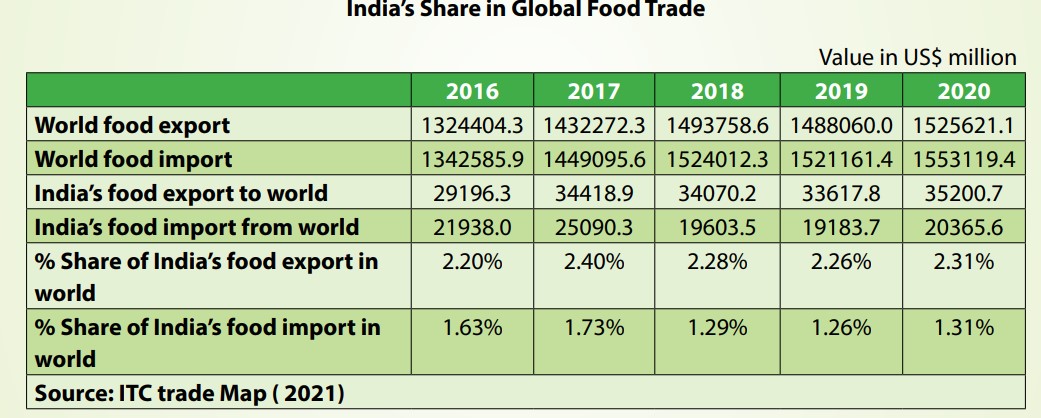
Factors Driving India's Processed Food Export Potential
- Abundant agricultural raw material supply: India is the world’s second-largest producer of fruits and vegetables, the largest producer of milk, and a major producer of cereals, spices, and other agricultural commodities.
- Skilled workforce and technological advancements: India has a large pool of skilled labor and is making significant investments in food processing technology, enabling it to enhance product quality and efficiency
- Growing domestic demand: The rising middle-class population and changing consumer preferences in India are driving the demand for processed and convenience food products, providing a solid foundation for export-oriented growth.
- Government initiatives: The Government of India has implemented various policies and schemes, such as the Pradhan Mantri Kisan SAMPADA Yojana, to promote the food processing industry and boost exports.
Chapter 4: Emerging Food Processing Technologies
The food processing industry is constantly evolving, with the adoption of innovative technologies to enhance product quality, safety, and sustainability. These technological advancements hold the potential to transform the way food is processed, preserved, and distributed, ultimately benefiting consumers and the environment.
- Valorization
- Valorization refers to the process of extracting and utilizing valuable components from food waste or by-products generated during food processing.
- This technology aims to convert waste streams into high-value products, such as food ingredients, nutraceuticals, or biofuels, thereby reducing environmental impact and improving the overall sustainability of the food system.
- Examples of valorization include extracting antioxidants from fruit peels, converting whey (a byproduct of cheese production) into protein supplements, and converting food waste into biofuels.
- Valorization not only reduces waste but also generates additional revenue streams for food processing companies, enhancing their overall profitability and competitiveness.
- Irradiation
- Irradiation is a food processing technique that involves exposing food products to controlled levels of ionizing radiation, such as gamma rays, electron beams, or X-rays.
- This technology can effectively eliminate harmful pathogens, extend the shelf life of food products, and reduce the need for chemical preservatives, thereby improving food safety and quality.
- The process is approved by regulatory bodies worldwide, including the World Health Organization (WHO) and the International Atomic Energy Agency (IAEA), and is considered a safe and effective method of food processing.
- High Pressure Processing (HPP)
- It is a non-thermal food processing technique that subjects food products to extremely high levels of hydrostatic pressure, typically ranging from 400 to 600 MPa (megapascals).
- It can effectively inactivate pathogenic and spoilage microorganisms without the need for heat treatment, preserving the nutritional and sensory qualities of the food.
- HPP is particularly useful for processing fresh, minimally processed, and ready-to-eat food products, as it can extend their shelf life while maintaining their natural flavors, textures, and nutritional profiles.
- Extrusion:
- Extrusion involves forcing a raw material mixture through a die under the influence of heat, pressure, and mechanical shear, resulting in physical and chemical transformations.
- It allows for the production of a wide variety of food products, including breakfast cereals, snacks, pasta, and even meat analogues.
- It enhances the nutritional value of food products, improves texture and sensory properties, and enables the utilization of food processing by-products and waste streams.
- Dielectric Heating:
- Dielectric heating is a method of heating materials by subjecting them to a high-frequency electric field. The electric field causes the molecules in the material to align themselves, resulting in heat generation due to friction between the molecules. This method is widely used in industrial processes such as drying, curing, and cooking, among others.
Chapter 5: Production Linked Incentives Scheme for Food Processing Industry
The food processing sector in India is a crucial component of the country’s economy, encompassing manufacturing enterprises from micro to large industries.
- India’s competitive advantages in terms of resource endowment, large domestic market, and scope for promoting value-added products make this sector ripe for growth.
- To unlock the full potential of the food processing industry, the Government of India has launched the Production Linked Incentive Scheme for Food Processing Industry (PLISFPI).
Objectives of the PLISFPI Scheme
- Support food manufacturing entities with stipulated minimum Sales and willing to make minimum stipulated investment for expansion of processing capacity and branding abroad to incentivize emergence of strong Indian brands.
- Support creation of global food manufacturing champions.
- Strengthen select Indian brands of food products for global visibility and wider acceptance in the international markets.
- Increase employment opportunities of off-farm jobs.
- Ensure remunerative prices of farm produce and higher income to farmers.
Production Linked Incentive (PLI) Scheme:It is a form of performance-linked incentive scheme launched by Government of India to give companies incentives on incremental sales from products manufactured in domestic units. It is aimed at boosting the manufacturing sector and to reduce imports. |
Salient Features of the Scheme
- The scheme has a central sector outlay of ₹10,900 crore.
- The first component focuses on incentivizing the manufacturing of four major food product segments: Ready to Cook/Ready to Eat (RTC/RTE) foods including Millets based products, Processed Fruits & Vegetables, Marine Products, and Mozzarella Cheese.
- The second component relates to supporting branding and marketing abroad to incentivize the emergence of strong Indian brands.
- The scheme will be implemented over a 6-year period from 2021-22 to 2026-27.
Implementation and Targets
- The scheme will be rolled out on an all-India basis.
- A Project Management Agency (PMA) will be responsible for the appraisal of applications/proposals, verification of eligibility for support, and scrutiny of claims eligible for the disbursement of incentives.
- The incentive under the scheme would be paid for 6 years ending 2026-27, with the incentive payable for a particular year due for payment in the following year
- The implementation of the scheme is expected to facilitate the expansion of processing capacity to generate processed food output of ₹33,494 crore and create employment for nearly 2.5 lakh persons by the year 2026-27.
Initiatives for Food Processing Sector:
Pradhan Mantri Kisan SAMPADA Yojana (PMKSY)
- This comprehensive scheme, initially approved in 2017 as the ‘Scheme for Agro-Marine Processing and Development of Agro-Processing Clusters (SAMPADA)’, has been extended and expanded to achieve the goal of doubling farmers’ income by 2022.
- It is a centrally sponsored scheme with a total allocation of Rs. 6000 crores for the implementation period of 2016-2020, coterminous with the 14th Finance Commission cycle. The scheme has been further extended till 31.03.2026, with an allocation of Rs. 4600 crores, aligning it with the 15th Finance Commission cycle.
- Key objectives:
- Creation of modern infrastructure with efficient supply chain management from farm gate to retail outlet
- Boosting the growth of the food processing sector.
- Providing better returns to farmers
- Doubling farmers’ income
- Creating employment opportunities, especially in rural areas
- Reducing agricultural produce wastage
- Increasing the processing level and enhancing the export of processed foods
- 7 component schemes:
- Mega Food Parks
- Integrated Cold Chain and Value Addition Infrastructure
- Infrastructure for Agro-Processing Clusters
- Creation of Backward and Forward Linkages
- Creation/Expansion of Food Processing & Preservation Capacities
- Food Safety and Quality Assurance Infrastructure
- Human Resources and Institutions
- The scheme has also incorporated the ‘Operation Greens’ initiative, which was launched in 2018 for the integrated development of the Tomato, Onion, and Potato (TOP) value chain. The scope of ‘Operation Greens’ has been expanded to include 22 perishable products, such as Mango, Banana, Apple, Pineapple, Carrot, Cauliflower, and Beans.
- The PMKSY is expected to leverage an investment of Rs. 11,095.93 crore , benefiting 28,49,945 farmers and generating 5,44,432 direct and indirect employment opportunities in the country by the year 2025- 26.
PM Formalization of Micro food processing Enterprises (PMFME) Scheme
- It is a centrally sponsored scheme launched in 2020.
- The scheme is operational for a period of 5 years from 2020-21 to 2024-25 with an outlay of Rs. 10,000 Crore to support 2 lakh micro food processing enterprises.
- The funding ratios are as follows:
- 90:10 for North Eastern and Himalayan States
- 60:40 for UTs with legislature, with the remaining 100% funded by the Centre for other UTs
- 60:40 between Central and State Governments for other states
- The key objectives of the scheme are:
- Increase access to credit for existing micro food processing entrepreneurs, FPOs, Self Help Groups and Co-operatives
- Integrate enterprises with the organized supply chain by strengthening branding and marketing
- Support the transition of existing 2,00,000 enterprises into the formal framework
- Increase access to common services like processing facilities, laboratories, storage, packaging, marketing and incubation
- Strengthen institutions, research and training in the food processing sector
- Increase access to professional and technical support for the enterprises.
- Under the scheme, micro enterprises will get credit-linked subsidy at 35% of the eligible project cost, with a ceiling of Rs.10 lakh. The beneficiary contribution will be a minimum of 10%, with the balance coming from a loan.
- For FPOs/SHGs/Cooperatives, seed capital will be provided at Rs. 4 lakhs per SHG for loans to members for working capital and small tools. Additionally, grants will be provided for backward/forward linkages, common infrastructure, packaging, marketing, and branding.
- The nodal ministry for this scheme is the Ministry of Food Processing Industries.
Chapter 6: Smart Food Processing in India
The food processing industry is undergoing a transformative shift, driven by the rapid advancements in technology. From the integration of the Internet of Things (IoT) to the adoption of Artificial Intelligence (AI) and the implementation of robotics and automation, the industry is poised to unlock new levels of efficiency, quality, and sustainability.
Internet of Things (IoT) in Food Processing
- The integration of IoT in food processing enables real-time monitoring, data collection, and analysis across the supply chain.
- IoT-enabled sensors can track parameters such as temperature, humidity, and product quality, allowing for predictive maintenance, optimized resource utilization, and enhanced food safety
- IoT-powered traceability systems can improve supply chain visibility, enabling better inventory management and faster response to potential food safety issues.
- The adoption of IoT in food processing can lead to increased efficiency, reduced waste, and improved decision-making, ultimately enhancing the industry’s competitiveness.
Artificial Intelligence (AI) Applications
- AI-powered systems are revolutionizing various aspects of food processing, from product development to quality control and process optimization.
- AI-driven computer vision and machine learning algorithms can automate visual inspection, grading, and sorting of food products, improving consistency and reducing human error.
- It can help food processors anticipate demand, optimize production schedules, and minimize waste.
Robotics and Automation
- Robotics and automation are transforming the physical aspects of food processing, from material handling to packaging and palletizing.
- Robotic systems can perform repetitive, labor-intensive tasks with greater precision, speed, and consistency, improving productivity and worker safety.
- It can operate in harsh or hazardous environments, reducing the risk of human exposure to potential contaminants or injuries.
- The integration of robotics and automation in food processing can lead to cost savings, increased throughput, and enhanced product quality.
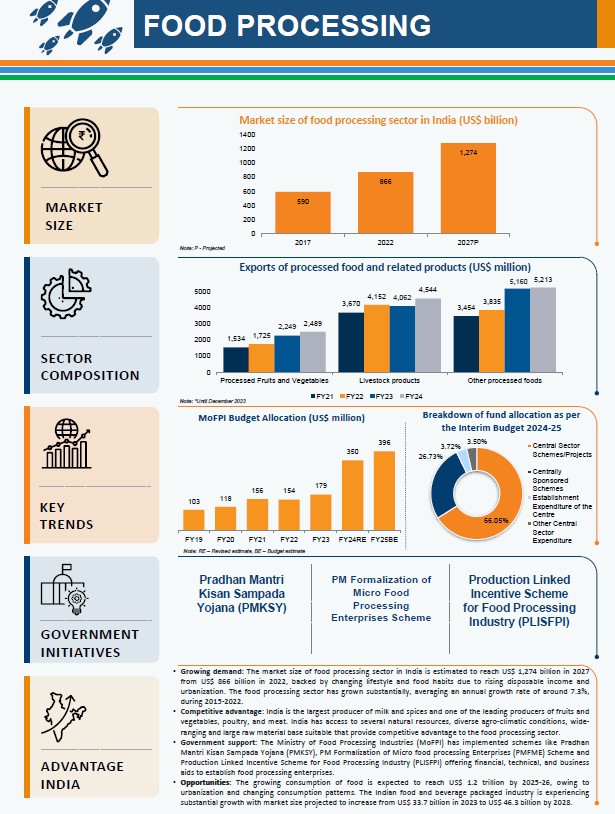
Mains Practice Question: - (in around 250 words)
Q1. Elaborate on the policy taken by the government of India to meet the challenges of the food processing sector.
Q2. What are the impediments in marketing and supply chain management in industry in India? Can e-commerce help in overcoming these bottlenecks?